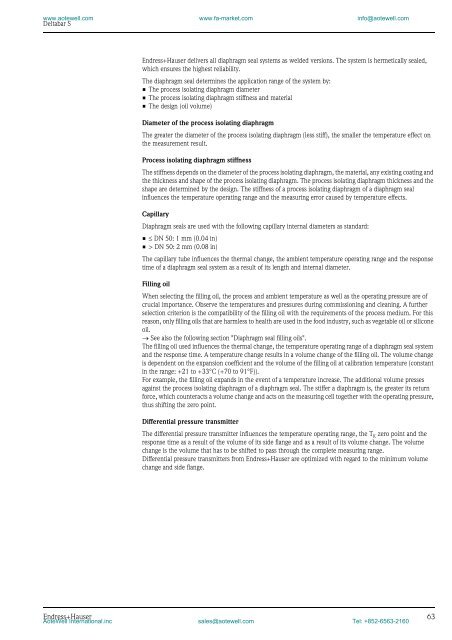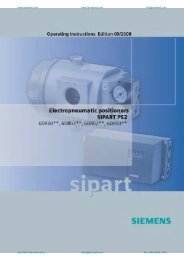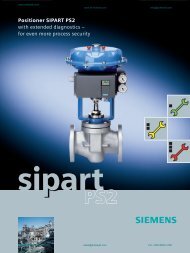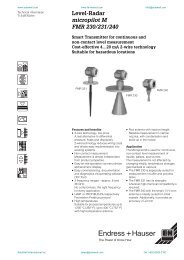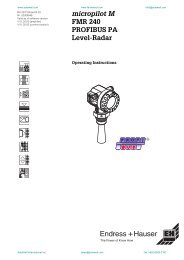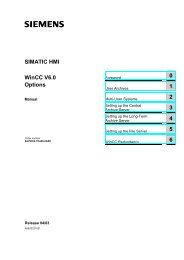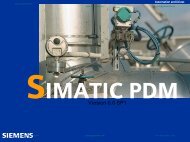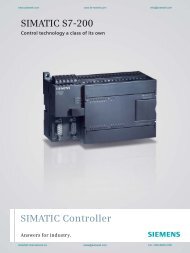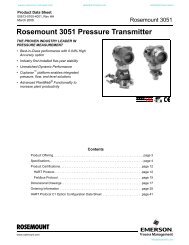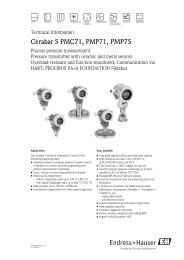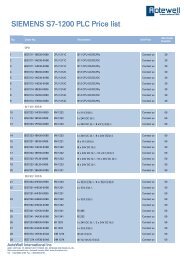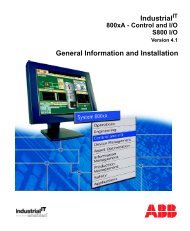Deltabar S PMD70/75 FMD76/77/78
Deltabar S, PMD70, PMD75, FMD76, FMD77, FMD78 - from AoteWell
Deltabar S, PMD70, PMD75, FMD76, FMD77, FMD78 - from AoteWell
- No tags were found...
Create successful ePaper yourself
Turn your PDF publications into a flip-book with our unique Google optimized e-Paper software.
www.aotewell.com www.fa-market.com info@aotewell.com<br />
<strong>Deltabar</strong> S<br />
Endress+Hauser delivers all diaphragm seal systems as welded versions. The system is hermetically sealed,<br />
which ensures the highest reliability.<br />
The diaphragm seal determines the application range of the system by:<br />
• The process isolating diaphragm diameter<br />
• The process isolating diaphragm stiffness and material<br />
• The design (oil volume)<br />
Diameter of the process isolating diaphragm<br />
The greater the diameter of the process isolating diaphragm (less stiff), the smaller the temperature effect on<br />
the measurement result.<br />
Process isolating diaphragm stiffness<br />
The stiffness depends on the diameter of the process isolating diaphragm, the material, any existing coating and<br />
the thickness and shape of the process isolating diaphragm. The process isolating diaphragm thickness and the<br />
shape are determined by the design. The stiffness of a process isolating diaphragm of a diaphragm seal<br />
influences the temperature operating range and the measuring error caused by temperature effects.<br />
Capillary<br />
Diaphragm seals are used with the following capillary internal diameters as standard:<br />
• DN 50: 1 mm (0.04 in)<br />
• > DN 50: 2 mm (0.08 in)<br />
The capillary tube influences the thermal change, the ambient temperature operating range and the response<br />
time of a diaphragm seal system as a result of its length and internal diameter.<br />
Filling oil<br />
When selecting the filling oil, the process and ambient temperature as well as the operating pressure are of<br />
crucial importance. Observe the temperatures and pressures during commissioning and cleaning. A further<br />
selection criterion is the compatibility of the filling oil with the requirements of the process medium. For this<br />
reason, only filling oils that are harmless to health are used in the food industry, such as vegetable oil or silicone<br />
oil.<br />
See also the following section "Diaphragm seal filling oils".<br />
The filling oil used influences the thermal change, the temperature operating range of a diaphragm seal system<br />
and the response time. A temperature change results in a volume change of the filling oil. The volume change<br />
is dependent on the expansion coefficient and the volume of the filling oil at calibration temperature (constant<br />
in the range: +21 to +33°C (+70 to 91°F)).<br />
For example, the filling oil expands in the event of a temperature increase. The additional volume presses<br />
against the process isolating diaphragm of a diaphragm seal. The stiffer a diaphragm is, the greater its return<br />
force, which counteracts a volume change and acts on the measuring cell together with the operating pressure,<br />
thus shifting the zero point.<br />
Differential pressure transmitter<br />
The differential pressure transmitter influences the temperature operating range, the T K zero point and the<br />
response time as a result of the volume of its side flange and as a result of its volume change. The volume<br />
change is the volume that has to be shifted to pass through the complete measuring range.<br />
Differential pressure transmitters from Endress+Hauser are optimized with regard to the minimum volume<br />
change and side flange.<br />
Endress+Hauser 63<br />
AoteWell International.inc sales@aotewell.com Tel: +852-6563-2160


